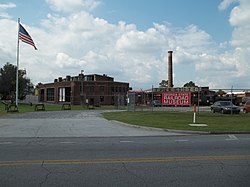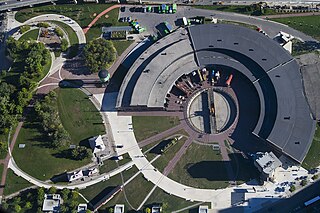
A railway roundhouse is a building with a circular or semicircular shape used by railways for servicing and storing locomotives. Traditionally, though not always the case today, these buildings surrounded or were adjacent to a turntable.
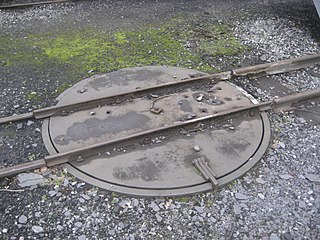
In rail terminology, a railway turntable or wheelhouse is a device for turning railway rolling stock, usually locomotives, so that they can be moved back in the direction from which they came. it is especially used in areas where economic considerations or a lack of sufficient space have served to weigh against the construction of a turnaround wye. In the case of steam locomotives, railways needed a way to turn the locomotives around for return trips as their controls were often not configured for extended periods of running in reverse and in many locomotives the top speed was lower in reverse motion. In the case of diesel locomotives, though most can be operated in either direction, they are treated as having "front ends" and "rear ends". When a diesel locomotive is operated as a single unit, the railway company often prefers, or requires, that it be run "front end" first. When operated as part of a multiple unit locomotive consist, the locomotives can be arranged so that the consist can be operated "front end first" no matter which direction the consist is pointed. Turntables were also used to turn observation cars so that their windowed lounge ends faced toward the rear of the train.
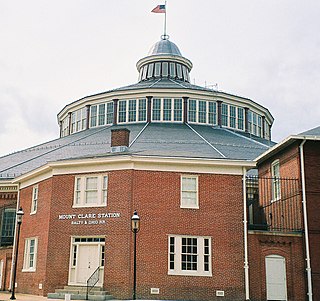
The B&O Railroad Museum is a museum and historic railway station exhibiting historic railroad equipment in Baltimore, Maryland. The Baltimore and Ohio Railroad (B&O) company originally opened the museum on July 4, 1953, with the name of the Baltimore & Ohio Transportation Museum. It has been called one of the most significant collections of railroad treasures in the world and has the largest collection of 19th-century locomotives in the U.S. The museum is located in the Baltimore and Ohio Railroad's old Mount Clare Station and adjacent roundhouse, and retains 40 acres of the B&O's sprawling Mount Clare Shops site, which is where, in 1829, the B&O began America's first railroad and is the oldest railroad manufacturing complex in the United States.

The Duluth, Missabe and Iron Range Railway (DM&IR), informally known as the Missabe Road, was a railroad operating in northern Minnesota and Wisconsin that used to haul iron ore and later taconite to the Great Lakes ports of Duluth and Two Harbors, Minnesota. Control of the railway was acquired on May 10, 2004, by the Canadian National Railway (CN) when it purchased the assets of Great Lakes Transportation.
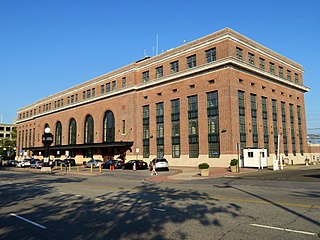
New Haven Union Station is the main railroad passenger station in New Haven, Connecticut. It is the third such station in the city of New Haven, preceded by both an 1848 built station in a different location, and an 1879 built station near the current station's location. Designed by noted American architect Cass Gilbert, the present beaux-arts Union Station was completed and opened in 1920 after the previous Union Station was destroyed by fire. It served the New York, New Haven and Hartford Railroad for the next five decades, but fell into decline following World War II along with the United States railroad industry as a whole.

The Denver, South Park, and Pacific Railroad was a historic 3 ft narrow gauge railroad that operated in Colorado in the western United States in the late 19th century. The railroad opened up the first rail routes to a large section of the central Colorado mining district in the decades of the mineral boom. The railroad took its name from the fact that its main line from Denver ascended the Platte Canyon and traversed South Park, hence its popular name "The South Park Line." Despite its lofty goals, the line never connected itself with the Pacific or any transcontinental line, apart from its terminal at Denver Union Station.

The Central of Georgia Railway started as the Central Rail Road and Canal Company in 1833. As a way to better attract investment capital, the railroad changed its name to Central Rail Road and Banking Company of Georgia. This railroad was constructed to join the Macon and Western Railroad at Macon, Georgia, in the United States, and run to Savannah. This created a rail link from Chattanooga, on the Tennessee River, to seaports on the Atlantic Ocean. It took from 1837 to 1843 to build the railroad from Savannah to the eastern bank of the Ocmulgee River at Macon; a bridge into the city was not built until 1851.
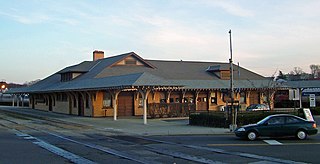
The Danbury Railway Museum is a railway museum housed in the former Union Station on the east end of downtown Danbury, Connecticut, United States. It was established in the mid-1990s following the closure of the station by the Metro-North Railroad in favor of a new station nearby, and primarily focuses on the history of railroading in southern New England and neighboring New York. In addition to the former station building, the museum has a collection of heritage railcars in the neighboring rail yard it shares with Metro-North.
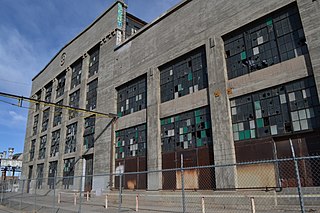
The former Santa Fe Railway Shops in Albuquerque, New Mexico, consist of eighteen surviving buildings erected between 1915 and 1925. The complex is located south of downtown in the Barelas neighborhood, bounded by Second Street, Hazeldine Avenue, Commercial Street, and Pacific Avenue. The shops were one of four major maintenance facilities constructed by the Atchison, Topeka and Santa Fe Railway, the others being located in Topeka, Kansas, Cleburne, Texas, and San Bernardino, California. The railway shops were the largest employer in the city during the railroad's heyday. Currently they have been empty for years but a variety of plans have been proposed for the historic complex.
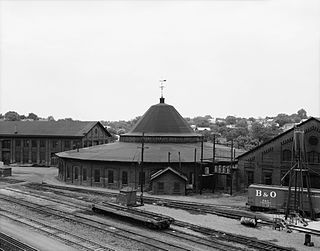
Baltimore and Ohio Railroad Martinsburg Shops is a historic industrial district in Martinsburg, West Virginia. It is significant both for its railroading architecture by Albert Fink and John Rudolph Niernsee and for its role in the Great Railroad Strike of 1877. It consists of three contributing buildings, one of which is the oldest covered roundhouse in the United States. The presence of the Baltimore and Ohio Railroad Company in Martinsburg dates back to the late 1840s, when the first engine and machine shops were erected for the expanding company.

Central of Georgia Railway Company Shop Property is the former administration building of the Central of Georgia Railway. The site complex includes several notable structures, including a freight house, a cotton yard with brick gates which it shares with the Central of Georgia Depot and Trainshed, and a brick viaduct leading to a junction with the line along Louisville Road west of Boundary Street and the Savannah and Ogeechee Canal. The tracks were also located next to "The Gray Building," a Greek Revival structure built in 1856, which the C&G moved their headquarters to. This building became known as "The Red Building."

Central of Georgia Depot and Trainshed is a former passenger depot and trainshed constructed in 1860 by the Central of Georgia Railway (CofG) before the outbreak of the American Civil War. This pair of buildings was declared a National Historic Landmark in 1976, a listing that was expanded in 1978 to the old Central of Georgia Railway Savannah Shops and Terminal Facilities.

The Southern Railway Spencer Shops are a former locomotive repair facility in Spencer, North Carolina. The shops were one of the Southern Railway's primary maintenance facilities. The shops were built in the 1890s and named after Southern Railway president Samuel Spencer. Following dieselization, the need for the Spencer Shops diminished, and the facilities were decommissioned in the 1970s. The Spencer Shops and associated land were donated by the Southern Railway to the state of North Carolina, which established the North Carolina Transportation Museum on the site.

The Mount Clare Shops is the oldest railroad manufacturing complex in the United States, located in Baltimore, Maryland. It was founded by the Baltimore and Ohio Railroad (B&O) in 1829. Mt. Clare was the site of many inventions and innovations in railroad technology. It is now the site of the B&O Railroad Museum. The museum and Mt. Clare station were designated a National Historic Landmark in 1961.

The SCAD Museum of Art was founded in 2002 as part of the Savannah College of Art and Design in Savannah, Georgia, and originally was known as the Earle W. Newton Center for British American Studies.

The Baltimore and Ohio Related Industries Historic District comprises a portion of Martinsburg, West Virginia to either side of the Baltimore and Ohio Railroad line as it runs through the city. The district includes the Baltimore and Ohio Railroad Martinsburg Shops, a National Historic Landmark, and a variety of industrial and commercial concerns that depended on the railroad.

Colver Historic District is a national historic district located at Barr Township and Cambria Township in Cambria County, Pennsylvania. The district includes 336 contributing buildings, 5 contributing sites, and 3 contributing structures. The district consists of residential areas, coal mining resources, Cambria and Indiana Railroad shop buildings, and a dairy farm associated with the Ebensburg Coal Company's mine and developed between 1911 and 1943. Notable buildings include a variety of brick and frame workers' housing, the Ebensburg Coal Company office building (1914), stone company store (1912), Colver Amusement Company (1912), Colver Hotel (1912), Colver Presbyterian Church (1915), public school (1927), hospital (1914), Roundhouse No. 1 (1918), Roundhouse No. 2 (1920), and main power building (1911).

Delaware, Lackawanna and Western Railroad Yard-Dickson Manufacturing Co. Site is a national historic district located in Scranton, Lackawanna County, Pennsylvania. It encompasses the Steamtown National Historic Site and Scranton Army Ammunition Plant and includes 16 contributing buildings, four contributing sites, and five contributing structures. The yard includes buildings and structures related to the yard's expansion in 1899-1939, and its usage as steam locomotive maintenance complex. The Dickson Manufacturing Company built steam locomotives, and the site of its works are included in this district.

The Finley Roundhouse is a historic railway roundhouse located in the Acipco-Finley neighborhood of Birmingham, Alabama. It is one of the last two surviving railway roundhouses in the City of Birmingham and one of three surviving in the State of Alabama. It is also the largest reinforced concrete roundhouse in Alabama. It was built by the Southern Railway in 1915.
